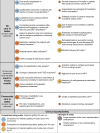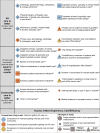Veterans Health Administration (VA) vs. Non-VA Healthcare Quality: A Systematic Review
- PMID: 37076605
- PMCID: PMC10361919
- DOI: 10.1007/s11606-023-08207-2
Veterans Health Administration (VA) vs. Non-VA Healthcare Quality: A Systematic Review
Abstract
Background: The Veterans Health Administration (VA) serves Veterans in the nation's largest integrated healthcare system. VA seeks to provide high quality of healthcare to Veterans, but due to the VA Choice and MISSION Acts, VA increasingly pays for care outside of its system in the community. This systematic review compares care provided in VA and non-VA settings, and includes published studies from 2015 to 2023, updating 2 prior systematic reviews on this topic.
Methods: We searched PubMed, Web of Science, and PsychINFO from 2015 to 2023 for published literature comparing VA and non-VA care, including VA-paid community care. Records were included at the abstract or full-text level if they compared VA medical care with care provided in other healthcare systems, and included clinical quality, safety, access, patient experience, efficiency (cost), or equity outcomes. Data from included studies was abstracted by two independent reviewers, with disagreements resolved by consensus. Results were synthesized narratively and via graphical evidence maps.
Results: Thirty-seven studies were included after screening 2415 titles. Twelve studies compared VA and VA-paid community care. Most studies assessed clinical quality and safety, and studies of access were second most common. Only six studies assessed patient experience and six assessed cost or efficiency. Clinical quality and safety of VA care was better than or equal to non-VA care in most studies. Patient experience in VA care was better than or equal to experience in non-VA care in all studies, but access and cost/efficiency outcomes were mixed.
Discussion: VA care is consistently as good as or better than non-VA care in terms of clinical quality and safety. Access, cost/efficiency, and patient experience between the two systems are not well studied. Further research is needed on these outcomes and on services widely used by Veterans in VA-paid community care, like physical medicine and rehabilitation.
Keywords: VA; access; community care; cost; inpatient; outpatient; patient experience; quality; safety.
© 2023. This is a U.S. Government work and not under copyright protection in the US; foreign copyright protection may apply.
Conflict of interest statement
The authors have no conflicts of interest to disclose.
Figures



Similar articles
-
Comparing Quality of Care in Veterans Affairs and Non-Veterans Affairs Settings.J Gen Intern Med. 2018 Oct;33(10):1631-1638. doi: 10.1007/s11606-018-4433-7. Epub 2018 Apr 25. J Gen Intern Med. 2018. PMID: 29696561 Free PMC article.
-
Expansion of the Veterans Health Administration Network and Surgical Outcomes.JAMA Surg. 2022 Dec 1;157(12):1115-1123. doi: 10.1001/jamasurg.2022.4978. JAMA Surg. 2022. PMID: 36223115 Free PMC article.
-
Analysis of Reported Suicide Safety Events Among Veterans Who Received Treatment Through Department of Veterans Affairs-Contracted Community Care.Mil Med. 2023 Aug 29;188(9-10):e3173-e3181. doi: 10.1093/milmed/usad088. Mil Med. 2023. PMID: 37002596 Free PMC article.
-
Moving From Discovery to System-Wide Change: The Role of Research in a Learning Health Care System: Experience from Three Decades of Health Systems Research in the Veterans Health Administration.Annu Rev Public Health. 2017 Mar 20;38:467-487. doi: 10.1146/annurev-publhealth-031816-044255. Epub 2017 Jan 11. Annu Rev Public Health. 2017. PMID: 28125386 Review.
-
Interorganizational Care Coordination of Rural Veterans by Veterans Affairs and Community Care Programs: A Systematic Review.Med Care. 2021 Jun 1;59(Suppl 3):S259-S269. doi: 10.1097/MLR.0000000000001542. Med Care. 2021. PMID: 33976075 Free PMC article.
Cited by
-
Drivers of Veterans' Healthcare Choices and Experiences with Veterans Affairs and Civilian Healthcare.Healthcare (Basel). 2024 Sep 14;12(18):1852. doi: 10.3390/healthcare12181852. Healthcare (Basel). 2024. PMID: 39337193 Free PMC article.
-
Association of Race and Ethnicity With Stroke and Mortality Outcomes in Atrial Fibrillation.JACC Adv. 2025 Jul;4(7):101860. doi: 10.1016/j.jacadv.2025.101860. Epub 2025 Jun 5. JACC Adv. 2025. PMID: 40479797 Free PMC article.
-
Lower comorbidity scores and severity levels in Veterans Health Administration hospitals: a cross-sectional study.BMC Health Serv Res. 2024 May 8;24(1):601. doi: 10.1186/s12913-024-11063-3. BMC Health Serv Res. 2024. PMID: 38714970 Free PMC article.
-
Depression and Heart Failure in US Veterans.JAMA Netw Open. 2025 May 1;8(5):e259246. doi: 10.1001/jamanetworkopen.2025.9246. JAMA Netw Open. 2025. PMID: 40338547 Free PMC article.
-
Better end-of-life care in surgical patients: Veterans Affairs Bereaved Family Survey - a qualitative analysis.BMJ Support Palliat Care. 2025 Feb 26;15(2):270-280. doi: 10.1136/spcare-2024-004873. BMJ Support Palliat Care. 2025. PMID: 39578044 Free PMC article.
References
-
- Baker A. Crossing the Quality Chasm: A New Health System for the 21st Century. vol 323(7322). BMJ; 2011.
-
- Veterans Access, Choice, and Accountability Act of 2014, (2014).
-
- VA MISSON Act of 2018, (2018).

